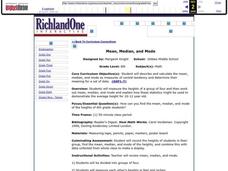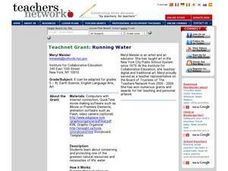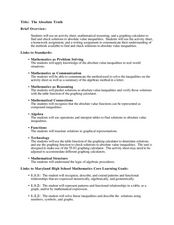Curated OER
Zero The Hero, Trout The Lout
Learners use a graphic organizer create a character sketch of Trout Walker from the novel Holes. Using the provided worksheet, students fill in the important character traits of Trout. Worksheet and answer key are provided with the lesson.
Curated OER
Käthe Kollwitz: Never Again War!
Students explore the artistic works of Holocaust escapee Käthe Kollowitz. In this Holocaust art lesson, students examine the self-portraits that Kollowitz created and discuss the message in her woodcut images. Students design their own...
Curated OER
Plant Cycles
Young scholars identify plants parts and their functions. In this plant cycle lesson, students examine parts of plants and how the parts help them survive in its environment. Young scholars use graphic organizers, the internet, books...
Curated OER
Working With Coins
Students arrange coins based on their value. In this coins lesson plan, students trace and record the value of each coin. Students count up to find the total value of all the coins.
Curated OER
Early Explorers
Fifth graders research European explorers. In this world history lesson, 5th graders will compare eight European explorers and identify important factual information about each. Students will be engaged through game-play and...
Curated OER
The Search for Pythagoras' Treasure
Students identify and define properties of triangles. For this geometry lesson, students identify the missing sides and angles of right triangles. They use the rules of the Pythagorean Theorem to solve their problems.
Curated OER
Splendid China
Sixth graders gain an appreciation for the traditions and vast contributions of the Chinese culture in this unit of lessons.
Curated OER
Creating Your Own Web Site
Students explore and explain how to design Web pages complete with text, graphics, and hypertext links. After adding backgrounds, navigation buttons, and audio-visual effects, and revising their work based on comments from peers and...
Curated OER
Mean, Median, and Mode
Young scholars calculate measures of central tendency. in this mean, median, and mode lesson, students calculate the measures of central tendency. They organize data, examine and explain the statistics.
Curated OER
Focus on the Media
Learners critically examine news articles and editorials for attitudes of discrimination and prejudice. Students then complete checklist in which they analyze news reports for context, content, point of view, language, graphics, and...
Curated OER
Jefferson Administration
Students research the major domestic issues that were present during the administration of Thomas Jefferson including the acquisition of the Louisiana Territory, Lewis and Clark's expedition, and his foreign policy. They investigate...
Curated OER
Create-A-Puppet
In this art worksheet, learners collect information from a given website to create scrap puppets. Students write their ideas about materials and designs in a graphic organizer. Learners also write down tips from the website.
Curated OER
The Big Bang Theory
Students explore the Big Bang Theory and discover how it can be used to explain the origin of the universe. For this Big Bang Theory lesson, students use a balloon with colored paper inside, blow it up and pop it, group the colored...
Curated OER
I Dig Your Art, Man (or Woman)
Twelfth graders write a thesis regarding a modern artist of their choice for a 15-20 multi-media presentation. In this lesson students create a Power Point, video, or some other visual representation studying an artist or modern artistic...
Curated OER
Persistent Drop of Water
Seventh graders investigate the meaning of personal persistence. In this personal persistence lesson, 7th graders fill in a Frayer Method graphic organizer after participating in a discussion of the formation of the Grand Canyon. They...
Curated OER
The Normal Distribution
Students investigate normal distribution. In this statistical analysis lesson plan students investigate the variety of circumstances in which the normal distribution can be used. Students apply the normal distribution to solve problems.
Curated OER
Breaking the Cycle of Payday Loan 'Trap'
High schoolers explore the concept of payday loans. In this payday loans lesson, students read an article about alternatives to payday loans. High schoolers discuss problems that are associated with payday loans. Students discuss why...
Curated OER
The Family Tree
In this patterns practice worksheet, students read a 3-paragraph excerpt regarding a family tree and respond to 1 graphic organizer question and 1 short answer question.
Curated OER
Joseph Mallord William Turner
Students identify the art and style of artist Joseph Mallord William Turner. In this art analysis lesson, students read about the life and art of Turner. Students study his paintings of keel men, his art style, and impasto technique....
Curated OER
Age of Exploration: A Comprehensive Research Project
Fifth graders examine reasons for exploration, the outcomes, and various explorers. In this age of exploration lesson, 5th graders create a flipbook with timeline and images to showcase their knowledge.
Curated OER
The Plan of Government under the U.S. Constitution
Students explore the U.S. plan for federal government. In this U.S. Constitution activity, students investigate a chart on the responsibilities of the Executive, Judicial, and Legislative Branches of governments. Students complete a...
Curated OER
Running Water
Sixth graders create products that feature the importance of water conservation. In this environmental stewardship lesson, 6th graders explore the water cycle and conduct on water usage. Students also research water pollution and...
Curated OER
Evaluate Problem-Solving in the Context of Culture and Time-frame
Students examine literary elements in non-fiction literature. In this problem solving lesson, students read Rosa Parks, My Story and Beyond the Limits. Students make oral presentations based on the causes and effects, conflicts, and...
Curated OER
The Absolute Truth
Students solve problems of inequalities and equations. In this algebra lesson, students add, subtract, multiply and divide to solve inequalities. They graph their solutions on a number line.

























